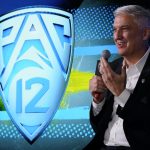The Heisman Trophy announced its four finalists for the 2024 award on Monday, with Colorado receiver/defensive back Travis Hunter, Boise State tailback Ashton Jeanty, Oregon quarterback Dillon Gabriel and Miami’s Cam Ward selected to attend the trophy ceremony on Saturday evening.
It’s the standard Heisman timeline the week after conference championship games, with one difference this year: Six days later, college football will begin a four-round, 12-team, month-long tournament.
College Football Playoff expansion has transformed the sport — to a greater extent, perhaps, than the creation of the four-team playoff a decade ago.
The Heisman? It hasn’t changed at all.
Since its inception in 1935, the Heisman has been presented at the conclusion of the regular season (and more recently, following the conference championship games).
“The Heisman prides itself on its tradition,” Tim Henning, associate director of the Heisman Trust, told the Hotline. “It has always been a regular-season award.”
That made loads of sense when teams played 11 in regular-season games and one bowl.
And when a 12th game was added in the mid-2000s.
And even when the four-team CFP was born in 2014.
But playoff expansion has changed the competitive math.
Three times as many teams have a chance to win multiple postseason games.
Three times as many players have a chance to write a script that will be remembered for decades.
Any team seeded No. 5 through No. 12 that reaches the championship will play one-quarter of its season after the Heisman ceremony.
What if Jeanty finishes second to Hunter on Saturday evening, as the Las Vegas oddsmakers expect, then steamrollers through two rounds of the CFP, easily breaks Barry Sanders’ hallowed single-season rushing mark — he needs 132 yards — and leads the Broncos into the championship?
Or what if Penn State tight end Tyler Warren, who isn’t a finalist, strings together four brilliant games and leads the Nittany Lions to the title?
Awarding a trophy for regular-season performance when the regular season is shrinking — both in impact on the sport and as a percentage of the total games played — could lead to diminished relevance for the Heisman.
The Heisman Trust, which oversees the voting and trophy presentation process, is well aware of the situation.
In fact, Heisman executives discussed the voting timeline during what Henning described as a “summit” last spring that featured key stakeholders, including ESPN.
The conclusion: Present the trophy between the conference championships and the start of the playoff, as usual.
There will be another summit this spring, Henning said, and the timing could very well appear on the agenda.
Any decision to move the voting window and trophy presentation to the other side of the playoff would be made by the Heisman Trust.
“We’re monitoring the situation,” Henning said.
The ESPN factor
What role might ESPN play in any decision to push back the Heisman presentation?
The network has exclusive broadcast rights to the trophy ceremony during a premium broadcast window: at 5 p.m. Pacific on the second Saturday of December, with no competition from the NFL and following the Army-Navy game.
Last year, the award ceremony drew 2.31 million viewers, according to SportsMediaWatch. For comparison, the Washington-Oregon game played 10 days ago drew 2.57 million, while the Miami-Syracuse matchup drew 2.11 million.
Henning said ESPN would “contribute” to any discussion about changing the Heisman’s timeline, but the Trust would have ultimate authority on the date of the ceremony.
On early voting
The Heisman’s voting window is a frequent source of concern and criticism.
Ballots are emailed on the Monday of championship week, providing the 928-person electorate with the option of voting before the conference title games are played.
Henning said logistical concerns prevent the Heisman from keeping the voting window closed until the conclusion of the championship games.
Too much could go wrong (e.g., ballots accidentally getting sent to spam folders) within what would be a narrow 36-hour voting window.
Asked how many voters cast ballots before the championship games, Henning said: “It’s a very, very small percentage.”
*** Editor’s note: Jon Wilner is a Heisman voter and the California Heisman state representative.
*** Send suggestions, comments and tips (confidentiality guaranteed) to wilnerhotline@bayareanewsgroup.com or call 408-920-5716
*** Follow me on the social media platform X: @WilnerHotline
Related posts:

(AP Photo/Marcio Jose Sanchez)
Wilner Hotline – Commissioner George Kliavkoff Q&A: On the Pac-12 as a leader, the COVID ‘hangover’ and his first year in charge Pac-12 survival guide: Examining the Fear Index as vultures circle and uncertainty looms
Pac-12 survival guide: Examining the Fear Index as vultures circle and uncertainty looms
 Wilner – Before the Pac-12 disappears: Our picks for the greatest players in conference history (the all-time team)
Wilner – Before the Pac-12 disappears: Our picks for the greatest players in conference history (the all-time team)
 On media: The top-rated games of 2024 (thus far) and how they reflect conference realignment
On media: The top-rated games of 2024 (thus far) and how they reflect conference realignment


